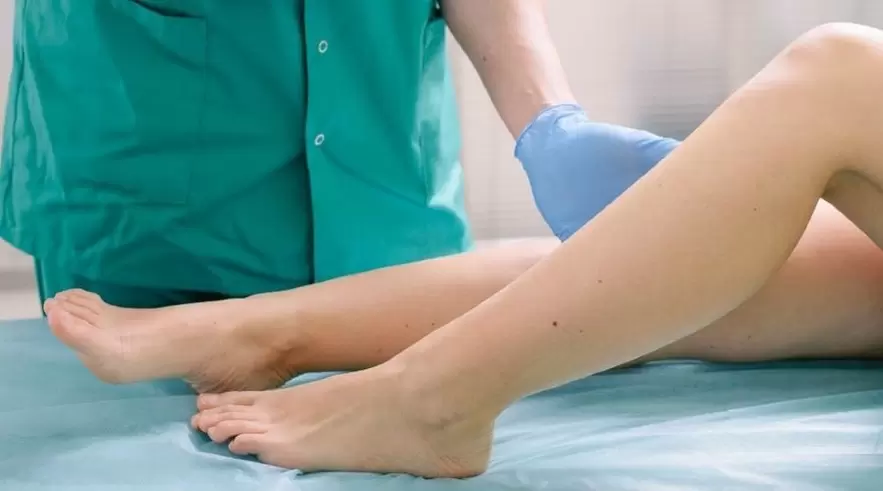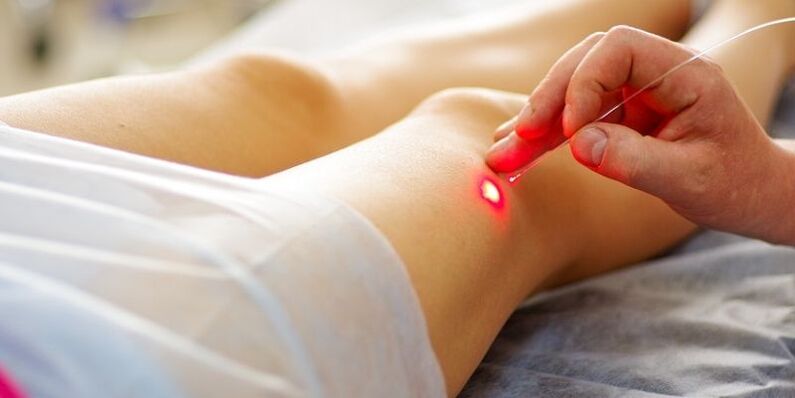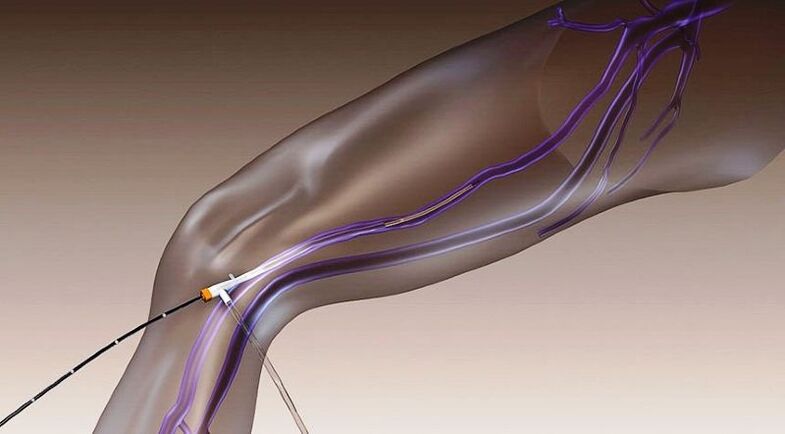
Varicose veins are a disease that affects approximately one-third of the world's population, which is quite a lot. In this regard, the therapy of this pathology requires modern and effective solutions.
Medicine is developing, modern methods for the treatment of varicose veins appear, which are increasingly less traumatic and invasive, which contributes to the rapid rehabilitation of the patient. Such procedures are performed in clinics.
How have varicose veins been treated in the past?
The problem of varicose veins has accompanied mankind since the moment he (man) was born. It is known that no other species of mammals suffers from this pathology, so people have been fighting it for a long time, for example:
- There is a cave painting found in the Sahara desert that depicts people with their legs bound and is approximately 5, 000 years old.
- In the discovered medical manuscripts of Egypt there is information that it is not necessary to touch the varicose veins under the skin, but many healers still experimented on the wives of the pharaohs - they burned the diseased veins.
- Native Americans of Central and South America used medicinal herbs, particularly amaranth, to treat varicose veins.
- Information about this pathology can also be found in the works of the Greeks (Hippocrates, Herophilus and Erasistratus). It should be noted that the first of these doctors developed both conservative and surgical methods of treatment.
- The Roman scientist Celsus used special hooks to fight pathology (interestingly, the devices are still used today for modern treatment of varicose veins, in particular with miniphlebectomy).
- As for China, it was customary to fight diseased blood vessels with the help of leeches, acupuncture and cauterization.
- In Japan, special attention is paid to conservative treatment.
- It is not for nothing that the Middle Ages are called "dark", because in Europe there were many prohibitions related to operations ("interference in God's affairs"), and the affected veins, as a rule, were simply cauterized.
- At the same time, medicine was actively developing in the Middle East - for example, the famous doctor Avicenna tightly bandaged diseased vessels (which today is mainly used for prevention or rehabilitation).
- The Renaissance, the New Age - all this is a period of discoveries, including in medicine. Doctors are increasingly studying the principles of venous circulation. Scientists are developing various surgical methods, some of which are still used today, new methods for sterile ligation of veins are being created.
In the 20th century, the laser procedure began to be studied and new, more effective treatment methods were created. This process is still going on without stopping for a minute. Of course, the way varicose veins are treated now is vastly different from the way it was in ancient times.
Modern methods of treating varicose veins
The newest methods of treating varicose veins are obliteration and coagulation of various types - these are the least traumatic manipulations. Let's take a closer look at some types of modern methods to combat varicose veins.
Endovenous laser coagulation

You can often find the abbreviated name of this method - EVLC. The principle of operation is as follows: a laser light guide is placed in the cavity of the diseased vein, which heats the blood. As a result, the vessels are sealed and for some time the vein turns into connective tissue. The process itself lasts 20-30 minutes, after which you may need to wear a special leotard for 40-60 minutes. Further conservative and compression treatment is determined by the doctor based on the medical history. This procedure can be performed on both lower limbs.
The advantages of this modern method of treating varicose veins are:
- duration – only 20-30 minutes;
- the manipulation does not require cutting, placing or removing threads, as the procedure is performed through a puncture;
- painlessness (performed under local anesthesia) and safety;
- quick recovery (on the day of the procedure you can return to your normal life);
- minimal trauma, excellent aesthetic appearance after intervention.
However, the treatment method also has contraindications, including:
- obesity in the legs;
- blood coagulation disorder;
- an extreme stage of the disease, for example, a pronounced expansion of the vein, which may require surgery or combined therapy;
- severe atherosclerosis of the arteries of the lower extremities, which requires a special approach;
- intolerance to anesthetics used in EVLT;
- period of pregnancy and breastfeeding;
- deep vein thrombosis in the acute phase;
- inflammation at the site of the lesion;
In addition, EVLT is usually not prescribed if the patient cannot move actively after the manipulation or if there is a disease that makes it impossible to wear special socks to prevent bruising or any complications.
Radiofrequency ablation

Another modern non-surgical type of treatment for varicose veins is radiofrequency obliteration, or RFO. The treatment is carried out using a radio frequency generator. Thus, through a special catheter with radiation, sound waves enter, which heat up and then narrow the walls of the vessel.
It is worth noting that the vein is completely sealed, after the procedure it is enough to treat the place of manipulation with an antiseptic and apply a sterile bandage. The peculiarity of this method is that the procedure can be prescribed for heart and kidney diseases, and not only for varicose veins.
RFO has the following advantages:
- painlessness (local anesthesia is used during application), as well as safety;
- duration no more than 40 minutes;
- visible results after only 7 days;
- minimal trauma, excellent aesthetic appearance;
- complete "gluing" of blood vessels;
- high efficiency;
- the ability to use this method if the patient has other diseases;
- no additional surgical intervention is required.
There are also contraindications to the use of this procedure. Between them:
- inflammatory process at the site of the lesion;
- infectious and viral pathologies;
- pregnancy and breastfeeding;
- venous thrombosis;
- severe atherosclerosis of the arteries of the lower extremities - as already mentioned, this pathology requires surgical intervention;
- allergic reaction to anesthetics that will be used during the procedure.
In addition, a contraindication is the circumstance when the patient has a pathology that prohibits him from wearing compression stockings.
Steam erasure
This method is one of the newest in the history of medicine. The so-called "steam injection" combines EVLT and RFO. It is the least invasive - compared to others - and is considered the most universal of all today. As with the procedures described above, steam obliteration does not require additional hospitalization.
The most pleasant advantage of the method is the possibility of its use at any stage - very deep veins can be treated with this type of intervention. The fact is that steam penetrates very quickly and without any special obstacles into the vessels, filling all the bends of the veins.
The principle of the method is as follows: water under pressure is pumped into a pipe that is heated with an electric current, and in this way the water changes its structure, turning into steam, which enters the vessel, where it turns into water again, while the vessel walls absorbthe heat generated by such a simple manipulation.
Like the procedures described above, this manipulation also does not last long. The patient recovers quickly and after completing the procedure and wearing compression stockings for 30-40 minutes, he can return to his usual way of life.
Mechanochemical erasure
It combines mechanical impact on the walls of blood vessels and treatment of the patient with chemicals. After a small puncture, a special catheter is placed at the site of the lesion. With its help, a device is inserted that damages the walls of the blood vessels, thereby sealing them. The manipulation is performed on the inner surface of the vein, which is why it does not require the use of anesthetics. At the end of the procedure, the puncture site is covered with a sterile bandage or napkin. In addition, the patient should wear compression stockings for 30-40 minutes.
Since obliteration does not require anesthesia, this method can be indicated if the patient has an intolerance to anesthetics. It is also recommended for people with a low pain threshold. In addition, this procedure can be performed if the patient has trophic ulcers.
Quick rehabilitation, the possibility of returning to a normal lifestyle as soon as possible, minimal restrictions during the recovery period - all these are the advantages of the above method of therapy. The advantage of mechanochemical obliteration is the reduced risk of infection due to minimal trauma.
Adhesive erasure
Another procedure that may be recommended for patients with varicose veins is called adhesive obliteration. It is noteworthy that after the completion of the manipulation, it is not necessary to wear special knitwear.
Like the other methods described above, this method does not require incisions: a special glue is injected into the lumen of the diseased vessel, which seals the inner walls and redirects blood circulation through healthy veins.
This method of treatment can be prescribed to patients who have a complication of varicose veins (as a rule, it is clearly visible on the lower leg). The intervention is also performed in patients with a large diameter of the affected veins (in contrast to the methods described above).
Which of the modern methods of treating varicose veins is the most effective?
All of the above methods of treating varicose veins are very effective, but each of them has its own characteristics, in which a specific procedure is recommended for a specific patient. If a person has contraindications to wearing compression stockings and/or has complications from varicose veins, they will be prescribed adhesive obliteration. If there is a possible allergic reaction to any anesthetic, a qualified specialist can prescribe mechanochemical obliteration.
Also, the criteria for choosing the most suitable method for treating varicose veins are as follows:
- Safety, no side effects.
- Efficiency.
- Duration of saving the result.
The last point is worth talking about separately, because this criterion is very indicative of one of the analyzes based on the results of 119 studies that compared RF, surgery, sclerotherapy and EVLT.
As a result, these results (indicators in percentages) show that:
- 5 years after the procedure, the efficiency of EVLT increased from 92. 9 to 95. 4. Compared to RFO, the efficiency of this method decreased over 5 years from 88. 9 to 79. 9.
- As for the results of surgical intervention, the effectiveness of this method decreased from 80. 4 to 75. 7 in 5 years. In the latter case, over 5 years you can also see a decrease in the effectiveness of sclerotherapy from 82. 1 to 73. 5, but procedures such as, for example, surgery are usually prescribed in cases where it is impossible to use more effective methodsfor treatment. varicose veins.
From the research, we can clearly conclude that today the most progressive and effective method of treating varicose veins is EVLT, because unlike the other methods with which the comparison was made, its effectiveness increases over time, and not the other way around, it decreases. It is worth noting that the clinics perform all the procedures mentioned in the article that can help the patient in the treatment of varicose veins.

















